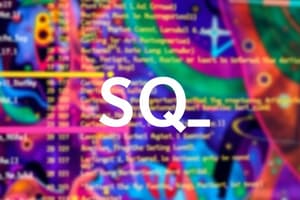Podcast
Questions and Answers
What type of information is typically managed under Enterprise Information in database applications?
What type of information is typically managed under Enterprise Information in database applications?
- Non-profit organization information
- Personal records of individuals
- Social media interaction data
- Sales, accounting, and human resources data (correct)
In the context of database applications, which of the following would fall under the accounting category?
In the context of database applications, which of the following would fall under the accounting category?
- Asset management (correct)
- Customer purchases
- Product inventory
- Employee salaries
Which of the following is NOT an example of data typically found in a human resources database application?
Which of the following is NOT an example of data typically found in a human resources database application?
- Salaries
- Payroll taxes
- Employee information
- Customer demographics (correct)
Which area would you likely find information about products and purchases in a database application?
Which area would you likely find information about products and purchases in a database application?
What is a primary purpose of utilizing databases in enterprise environments?
What is a primary purpose of utilizing databases in enterprise environments?
What is a primary focus of manufacturing management?
What is a primary focus of manufacturing management?
Which area is primarily concerned with customer information and banking transactions?
Which area is primarily concerned with customer information and banking transactions?
Which of the following is NOT typically managed within manufacturing?
Which of the following is NOT typically managed within manufacturing?
What component is essential to the management of production in manufacturing?
What component is essential to the management of production in manufacturing?
Which aspect does banking and finance NOT typically include?
Which aspect does banking and finance NOT typically include?
What does processed information refer to?
What does processed information refer to?
Which definition best describes relevant information?
Which definition best describes relevant information?
What does complete information provide?
What does complete information provide?
Why is processed information important?
Why is processed information important?
Which characteristic does NOT define complete information?
Which characteristic does NOT define complete information?
What does each row in a database table represent?
What does each row in a database table represent?
In a table, what does each column represent?
In a table, what does each column represent?
What is the primary purpose of a table in a database?
What is the primary purpose of a table in a database?
How do tables contribute to data organization in a database?
How do tables contribute to data organization in a database?
Which of the following is not characteristic of a table in a database?
Which of the following is not characteristic of a table in a database?
What best represents a distinction between data and information?
What best represents a distinction between data and information?
Which example illustrates data rather than information?
Which example illustrates data rather than information?
In which scenario is the output considered information?
In which scenario is the output considered information?
Which statement about data is correct?
Which statement about data is correct?
What is an example of information derived from data?
What is an example of information derived from data?
Which of the following represents a database?
Which of the following represents a database?
What is the role of data in regards to information and knowledge?
What is the role of data in regards to information and knowledge?
What would not be considered data?
What would not be considered data?
Flashcards are hidden until you start studying
Study Notes
Database Applications
- Sales: Track customer information, products, and purchases.
- Accounting: Manage payments, receipts, and assets.
- Human Resources: Store information about employees, salaries, and payroll taxes.
- Manufacturing: Manage production, inventory, orders, and the supply chain.
- Banking and Finance: Track customer information, accounts, loans, and banking transactions.
Data vs. Information
- Data is raw, unprocessed facts.
- Information is processed data that provides context and meaning.
- Relevant information is pertinent to a specific purpose.
- Complete information presents a complete view or understanding.
Examples of Data vs. Information
- Data: Individual homework and test grades for a student in one class.
- Information: The student's average grade for each class.
- Data: Typing "Universities in Oman" in a search engine.
- Information: The list of search results that includes universities in Oman.
- Data: A series of temperature readings (e.g., 24.5°C, 23.8°C, 25.0°C).
- Information: An average temperature of 24.4°C, indicating a mild climate.
Data to Information to Knowledge
- Data is transformed into information, then knowledge.
- Knowledge is understanding gained through data and information.
Database
- A collection of related data.
- A table is a fundamental database component that stores data in rows and columns.
- Each row represents a record, and each column represents a field.
- Tables provide structure to the data.
Studying That Suits You
Use AI to generate personalized quizzes and flashcards to suit your learning preferences.




